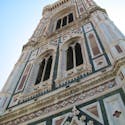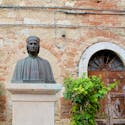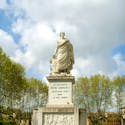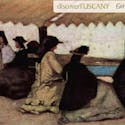The Birth of Italian Painting
The birth of religious painting corresponds often with the birth of Italian painting in its widest meaning. Among the founders and pioneers stands Cimabue, a Florentine painter of the 13th century.
Cimabue, whose life is not very well known, is mentioned by Dante Alighieri in his Divine Comedy as master of the magnificent Giotto, who obscured his success ("In painting Cimabue thought he held the field but now it's Giotto who has the cry, so that the other's fame is dimmed" Purgatory XI). Later on Vasari described him as the one who was born "to start enlightening the art of painting".
As a matter of fact, his works of art started a new tradition in style for painting that included emotions and developed away from Byzantine art. Cimabue and his student Giotto developed the foundation for significant changes in Italian painting.
His Life
Not much is known about the life of this great 13th century artist. We know the name Cimabue was given to him, but there are many contrasting opinions on what his real name was (John, Cenni or Bencivieni di Pepi).
What is generally agreed upon is that he was born in Florence in 1240 from a noble Florentine family that sent him to study Literature at the monastery of Santa Maria Novella. Here he comes into contact with great masters of the Byzantine art of mosaics that had come to Florence to create works of art. Soon he develops his own style, differing "in style, as well as in colors, from his masters" (Vasari).
Around 1270 he creates the wooden Crucifix of San Domenico Church in Arezzo and in 1272 goes to Rome. When he returns to Florence he creates the big wooden Crucifix for Santa Croce Church which was greatly damaged in the Florence flood of 1966.
Cimabue is most active around 1280, when he creates the beautiful Virgin and Child Enthroned found today at the Louvre Museum. In the following years, he paints masterpieces which are now displayed all round the world, such as the Flagellation at New York City's Frick Collection, the Virgin Enthroned of Santa Maria de' Servi in Bologna, sevral of the mosaics in the Florence Baptistery. It is during these years that he begins to work with Giotto.
Later on Pope Niccolò IV (1288-1292) commissions from Cimabue frescoes for the apse of the Superior Basilica of St. Francis in Assisi. The frescoes, depicting the four Evangelists, the Virgin's Life and two Crucifixions, are unfortunately greatly damaged today. In the Minor Basilica he frescoes a Madonna Enthroned with St. Francis. He gets this job thanks to his workmanship shown in Rome even if today none of his works from that period are still in existence.
At the end of 13th century he paints the Madonna Enthroned for the Church of Santa Trinita in Florence which is at the Uffizi Gallery today. Between 1301 and 1302 Cimabue is in Pisa to decorate with mosaics the Duomo's apse. He dies in 1302 without finishing his work on the cathedral.
His Works
Cimabue is renowned around the world as the founder of modern Italian painting. He was the first, in the 13th century, to differ from the Byzantine mosaics' style of art. His works are painted with emotions, more realistic and gentle figures. He was a pioneer for a more naturalistic style, made of a new concept of light and creativity, which his student Giotto then continued and expanded on.
Even though there is no official and complete catalog of his works, those recognized as his are certainly masterpieces which are today preserved in important museums in Italy and around the world.
Among his works from his youth is the beautiful wooden Crucifix of Santa Croce Church in Florence. Made around 1270, it depicts a suffering Christ, with gentle curves shaded by chiaroscuro. Unfortunately, the Crucifix was greatly damage by the flood of 1966.
He then realizes the Madonna with Child Enthroned, today at the Louvre Museum. This Madonna is more natural and proportioned more life-like. It becomes the new model for all painters that follow.
At the end of 1280 he frescoes the apse of the Superior Basilica of St.Francis in Assisi by representing the four Evangelists, the Virgin's Life and two Crucifixions. Even though the frescoes' colors are really ruined, you can notice the style and the dramatic nature of the figures. In the Minor Basilica he creates a fresco of a Madonna Enthroned with St.Francis.
Before going to Pisa where he has to decorate the mosaics of the Duomo's apse, and before his death in 1302, Cimabue realizes the beautiful Madonna Enthroned for the Church of Santa Trinita, displayed at the Uffizi Gallery today.
Cimabue in Tuscany
This famous Florentine painter of the 13th century is strongly related to Tuscany and many of his artworks are here.
In the Church of San Domenico in Arezzo there is the wooden Crucifix, one of his earlier works.
At the Uffizi Gallery is the beautiful Madonna Enthroned (Madonna in Maestà), created for the Church of Santa Trinita before his death.
Inside the Santa Croce Church stands the famous wooden Crucifix, damaged by the flood.
The Duomo of Pisa hosts the mosaic of St. John the Baptist, made in 1301 before his death.
In the small Religious Art Museum of St. Veridiana in Castelfiorentino, in the heart of Chianti, is a Madonna with Child attributed to Cimabue.
Other artworks by Cimabue are displayed at the Louvre Museum in Paris, in New York City and other famous museums around the world.



